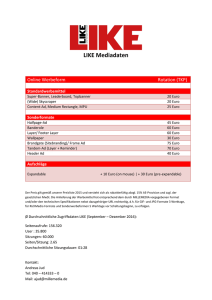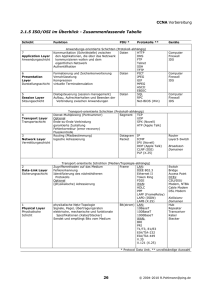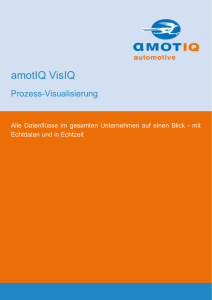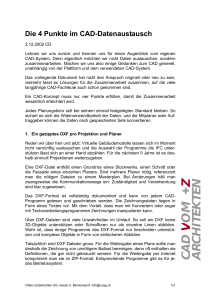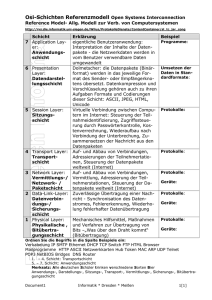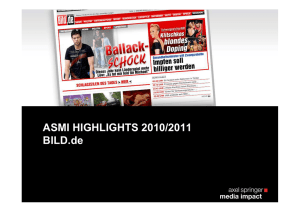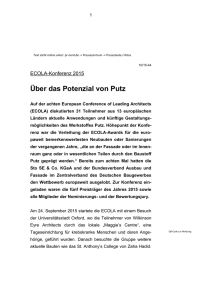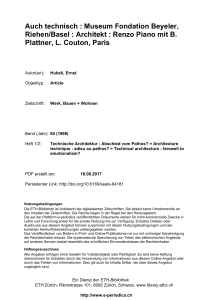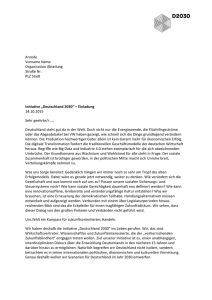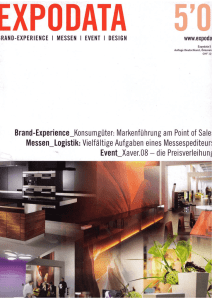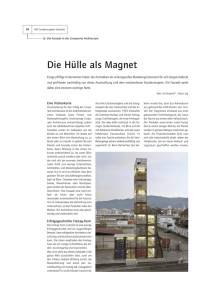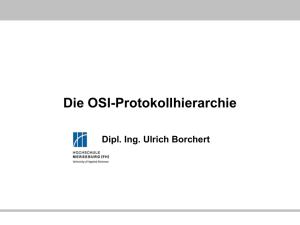Inhaltsverzeichnis Daniel Liebhart, Guido Schmutz, Marcel
Werbung
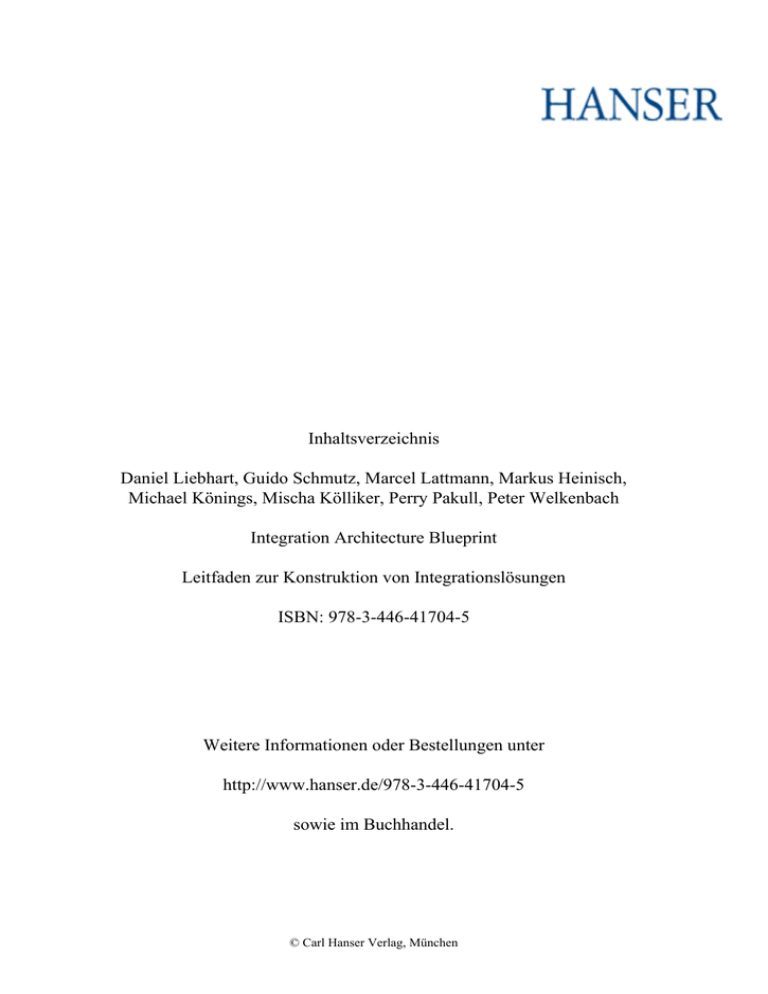
Inhaltsverzeichnis Daniel Liebhart, Guido Schmutz, Marcel Lattmann, Markus Heinisch, Michael Könings, Mischa Kölliker, Perry Pakull, Peter Welkenbach Integration Architecture Blueprint Leitfaden zur Konstruktion von Integrationslösungen ISBN: 978-3-446-41704-5 Weitere Informationen oder Bestellungen unter http://www.hanser.de/978-3-446-41704-5 sowie im Buchhandel. © Carl Hanser Verlag, München Inhalt Vorwort................................................................................................................................ IX Die Autoren.......................................................................................................................... XI 1 1.1 1.2 Einleitung ................................................................................................................... 1 Hintergrund: Integriert statt isoliert.............................................................................. 2 Aufbau des Buches ..................................................................................................... 3 2 2.1 2.2 Grundlagen ................................................................................................................ 5 Einleitung ................................................................................................................... 5 Begriffe....................................................................................................................... 7 2.2.1 A2A, B2B und B2C......................................................................................... 8 2.2.2 Integrationstypen............................................................................................ 9 2.2.3 Semantische Integration und die Rolle der Daten.......................................... 11 2.2.4 Enterprise Application Integration (EAI)......................................................... 13 2.2.5 Messaging .................................................................................................... 14 2.2.6 Publish-Subscribe ......................................................................................... 15 2.2.7 Message Broker ............................................................................................ 16 2.2.8 Messaging-Infrastruktur................................................................................. 18 2.2.9 Enterprise Service Bus (ESB).......................................................................... 18 2.2.10 Middleware.................................................................................................. 21 2.2.11 Routing Schemas .......................................................................................... 23 Integrations-Architekturvarianten............................................................................... 24 2.3.1 Point-to-Point-Architektur ............................................................................. 24 2.3.2 Hub-and-Spoke-Architektur .......................................................................... 25 2.3.3 Pipeline-Architektur...................................................................................... 26 2.3.4 Service-Orientierte Architektur ..................................................................... 27 Service-Oriented Integration ..................................................................................... 29 2.4.1 Process Integration ....................................................................................... 29 2.4.2 Workflow Integration.................................................................................... 31 Data Integration ........................................................................................................ 32 2.3 2.4 2.5 V Inhalt 2.6 2.7 2.8 3 3.1 3.2 3.3 3.4 3.5 3.6 3.7 3.8 VI 2.5.1 Federation.................................................................................................... 32 2.5.2 Population ................................................................................................... 33 2.5.3 Synchronisation............................................................................................ 35 EAI / EII..................................................................................................................... 37 2.6.1 Direct Connections ...................................................................................... 37 2.6.2 Broker.......................................................................................................... 38 2.6.3 Router.......................................................................................................... 40 Event Driven Architecture......................................................................................... 42 2.7.1 Einführung EDA ........................................................................................... 42 2.7.2 Event Processing........................................................................................... 44 GRID / XTP............................................................................................................... 46 2.8.1 GRID ........................................................................................................... 46 2.8.2 Einsatzgebiete .............................................................................................. 52 2.8.3 XTP (Extreme Transaction Processing)........................................................... 53 2.8.4 XTP und CEP................................................................................................ 55 2.8.5 Solid State Disks und Grids .......................................................................... 55 Basistechnologien .................................................................................................... 57 Einleitung ................................................................................................................. 57 Transaktionen ........................................................................................................... 59 3.2.1 Transaktionale Systeme ................................................................................ 59 3.2.2 Isolationsebenen (Isolation Levels)................................................................ 61 3.2.3 Zwei-Phasen-Commit-Protokoll (two-phase commit protocol, 2PC) ............... 64 3.2.4 XA-Transaktionen ......................................................................................... 66 OSGi........................................................................................................................ 67 3.3.1 OSGi-Architektur.......................................................................................... 69 3.3.2 OSGi Bundles .............................................................................................. 70 3.3.3 Das Kollaborative Modell ............................................................................. 71 Java Connector Architecture (JCA)............................................................................. 72 3.4.1 Einsatzgebiet ................................................................................................ 72 3.4.2 JCA Komponenten........................................................................................ 72 3.4.3 Contracts...................................................................................................... 73 Java Business Integration (JBI).................................................................................... 74 3.5.1 Die JBI-Bestandteile...................................................................................... 75 Service Component Architecture (SCA) ..................................................................... 76 3.6.1 SCA-Spezifikation......................................................................................... 77 3.6.2 SCA-Bausteine.............................................................................................. 78 3.6.3 Composite.................................................................................................... 79 Service Data Objects (SDO)...................................................................................... 80 3.7.1 SDO-Architektur........................................................................................... 80 3.7.2 Implementierte Pattern ................................................................................. 81 Prozessmodellierung ................................................................................................ 81 3.8.1 Ereignisgesteuerte Prozessketten (EPK).......................................................... 82 3.8.2 BPMN .......................................................................................................... 83 3.8.3 BPEL ............................................................................................................ 84 3.8.4 Die Anwendung der Prozessmodellierung .................................................... 84 Inhalt 4 4.1 4.2 4.3 4.4 4.5 4.6 4.7 5 5.1 5.2 Integration Architecture Blueprint ........................................................................... 87 Einleitung ................................................................................................................. 87 4.1.1 Warum ein Architecture Blueprint?............................................................... 89 Der Trivadis Integration Architecture Blueprint.......................................................... 90 4.2.1 Der Weg zum Integration Blueprint .............................................................. 92 4.2.2 Anwendungen und Integration ..................................................................... 93 4.2.3 Schichtung der Integrationslösung ................................................................ 95 4.2.4 Informationsfluss und Rollen ........................................................................ 96 4.2.5 Informationsfluss und Bausteine.................................................................... 97 4.2.6 Zusammenzug von Collection und Distribution Layer................................... 98 4.2.7 Richtungsänderung des Informationsflusses .................................................. 99 4.2.8 Erweiterung Process Layer .......................................................................... 100 4.2.9 Die Rolle des Process Layer........................................................................ 101 4.2.10 Die Bausteine des Process Layer ................................................................. 102 4.2.11 Informationsfluss in komplexeren Integrationen .......................................... 103 4.2.12 Zuordnung der Layer zu Level .................................................................... 107 Transport Level: Communication Layer ................................................................... 109 4.3.1 Ziel ............................................................................................................ 109 4.3.2 Konzepte / Techniken................................................................................. 109 4.3.3 Bausteine ................................................................................................... 110 Integration Domain Level: Collection / Distribution Layer ....................................... 114 4.4.1 Ziel ............................................................................................................ 114 4.4.2 Konzepte / Techniken................................................................................. 114 4.4.3 Bausteine ................................................................................................... 115 Integration Domain Level: Mediation Layer............................................................. 116 4.5.1 Ziel ............................................................................................................ 116 4.5.2 Konzepte / Techniken................................................................................. 116 4.5.3 Bausteine ................................................................................................... 117 Application Level: Process Layer ............................................................................. 120 4.6.1 Ziel ............................................................................................................ 120 4.6.2 Konzepte / Techniken................................................................................. 120 4.6.3 Bausteine ................................................................................................... 121 Notation und Visualisierung.................................................................................... 127 4.7.1 Darstellung der Szenarien und verwendete Notation .................................. 127 4.7.2 Visualisierung unterschiedlicher Granularität .............................................. 128 4.7.3 Darstellung der Transaktionsgrenzen .......................................................... 129 4.7.4 Konfigurationsparameter als zusätzliche Artefakte....................................... 130 4.7.5 Erweiterung für Kapazitätsplanung.............................................................. 131 Szenarien für die Umsetzung ................................................................................. 133 Szenarien der Service-Oriented Integration ............................................................. 134 5.1.1 Umsetzung des Process Integration Business-Patterns.................................. 134 5.1.2 Umsetzung des Workflow Business-Patterns ............................................... 137 Szenarien zur Data Integration ................................................................................ 138 5.2.1 Umsetzung des Federation Business-Patterns .............................................. 138 5.2.2 Umsetzung des Population Business-Patterns.............................................. 140 VII Inhalt 5.3 5.4 5.5 5.6 5.7 5.8 5.9 6 6.1 6.2 5.2.3 Umsetzung des Synchronization Business-Patterns ..................................... 145 Szenarien zu EAI / EII.............................................................................................. 146 5.3.1 Umsetzung des Direct Connections Business-Patterns................................. 146 5.3.2 Umsetzung des Broker Business-Patterns .................................................... 147 5.3.3 Umsetzung des Router Business-Patterns .................................................... 148 Szenario zu EDA..................................................................................................... 149 5.4.1 Umsetzung des Event Processing Business-Patterns..................................... 149 Szenario GRID/XTP ................................................................................................ 152 5.5.1 Umsetzung des Grid Computing Business-Patterns ..................................... 152 Anbindung an ein SAP-System ............................................................................... 153 Modernisierung einer Integrationslösung................................................................. 154 5.7.1 Ausgangslage ............................................................................................. 154 5.7.2 Modernisierung – Integration mit SOA ....................................................... 158 Trivadis Architecture Blueprints und Integration...................................................... 160 Produkte zur Umsetzung des Trivadis Integration Blueprints ................................... 163 5.9.1 Oracle Fusion Middleware Produktlinie...................................................... 163 5.9.2 Oracle Data Integrator................................................................................ 165 5.9.3 IBM WebSphere-Produktlinie ..................................................................... 167 5.9.4 IBM Information Management Software...................................................... 170 5.9.5 Microsoft BizTalk und .NET 3.0.................................................................. 172 5.9.6 Microsoft SQL Server Integration Services................................................... 176 5.9.7 Spring Framework in Kombination mit weiterer Open Source Software....... 178 Zusammenfassung.................................................................................................. 181 Aufbau des Integration Architecture Blueprints........................................................ 182 Produkteinsatz........................................................................................................ 185 6.2.1 Oracle Fusion Middleware ......................................................................... 186 6.2.2 Oracle Data Integrator................................................................................ 187 6.2.3 IBM WebSphere-Produktlinie ..................................................................... 188 6.2.4 IBM Information Management Software...................................................... 189 6.2.5 Microsoft BizTalk und .NET 3.0.................................................................. 190 6.2.6 Microsoft SQL Server Integration Services................................................... 191 6.2.7 Spring Framework in Kombination mit weiterer Open Source Software....... 192 Literatur ............................................................................................................................ 195 Register ............................................................................................................................. 201 VIII
